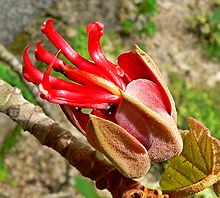Chiranthodendron is a flowering plant genus in the family Malvaceae. It comprises a single species of tree, Chiranthodendron pentadactylon.
| Chiranthodendron | |
|---|---|

| |
| Scientific classification | |
| Kingdom: | Plantae |
| Clade: | Tracheophytes |
| Clade: | Angiosperms |
| Clade: | Eudicots |
| Clade: | Rosids |
| Order: | Malvales |
| Family: | Malvaceae |
| Subfamily: | Bombacoideae |
| Genus: | Chiranthodendron Larreat. |
| Species: | C. pentadactylon
|
| Binomial name | |
| Chiranthodendron pentadactylon | |
Names edit
The tree is called the devil's, monkey's or Mexican hand tree or the hand-flower in English, the árbol de las manitas (tree of little hands) in Spanish, and mācpalxōchitl[2] (palm flower) in Nahuatl, all on account of its distinctive red flowers, which resemble open human hands. The scientific name means "five-fingered hand-flower tree".
Description edit
This species is native to Guatemala and southern Mexico.[1] On the wet slopes of these areas, trees may reach 10.5–27.5 m (34–90 ft) in height.[1] The unusual appearance of the 'hands' has stimulated cultivation in gardens around the world, primarily in North America where it grows well near its native range. The leaves are large and shallowly lobed, with a brown indumentum on the underside. The distinctive flowers appear in late spring and early summer; the five stamens are long, curved upward, and bright red, giving the distinct impression of a clawed hand. Its fruit is a 7.5–10 cm (3.0–3.9 in) long oblong, five-lobed capsule which contains black seeds.[1]
It was originally described from a single cultivated specimen grown in Toluca in the Toluca Valley, well outside the native range. The Aztecs revered the tree.[1]
-
Bark
-
Pods
-
Leaves
-
Open Chiranthodendron pentadactylon flower showing nectary and abundant nectar.
-
Chiranthodendron pentadactylon flower showing yellow pollen covered stamens.
Intergeneric hybrid edit
It is closely related to Fremontodendron, sufficiently to produce an intergeneric hybrid ×Chiranthofremontia lenzii Henrickson, which has yellow flowers and a reduced form of the claw.
Uses edit
The Aztecs and others have used solutions containing the tree's flowers as a remedy for lower abdominal pain[2] and for heart problems.[3][4] Such solutions also reduce edema and serum cholesterol levels and, because they contain the glycosides quercetin and luteolin, act as diuretics.[4] In Mexico and part of Central America, the flower is extracted in hot water and taken as tea for these medical purposes. It can also be used externally as a wash.[5]
References edit
- ^ a b c d e 2001, Elizabeth McClintock, The trees of Golden Gate Park and San Francisco, edited by Richard Turner (Jr.), ISBN 1-890771-28-7, page 65
- ^ a b Emory Dean Keoke, Kay Marie Porterfield, Encyclopedia of American Indian Contributions to the World (2002), page 118: "For lower abdominal pain, the patient would be prescribed macpalxochitl (Chiranthodendron)"
- ^ Journal of Ethnobiology, published by the Center for Western Studies (Flagstaff, Arizona), volume 3 (1983): "Flor de manita" (Chiranthodendron pentadactylon Larr.), a highly prized and effective heart remedy, is available fresh during the winter months.
- ^ a b Nina L. Etkin, Eating on the Wild Side: The Pharmacologic, Ecologic and Social Implications of Using Noncultigens (2000), page 26: The Aztec also used the blossoms of the hand-flower tree (Chiranthodendron pentadactylon) as a blood or heart tonic. [...] water-based solutions of the flowers reduce edema and serum cholesterol levels (Jiu 1966). [The tree...] also acts as a diuretic (due to the glycosides quercetin and luteolin) and, when ingested regularly as a decocted beverage, is most likely effective in treating cardiopulmonary insufficiency (Logan 1981).
- ^ "Little Hand Flower". Herbal Safety. Retrieved 15 March 2024.
External links edit
- Larréategui, J.D. (1805). Description Botanique du Chiranthodendron. p. 17.